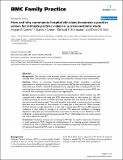| dc.contributor.author | Gerber, Megan R | |
| dc.contributor.author | Leiter, Karen S | |
| dc.contributor.author | Hermann, Richard C | |
| dc.contributor.author | Bor, David Harkavy | |
| dc.date.accessioned | 2010-12-09T15:01:52Z | |
| dc.date.issued | 2005 | |
| dc.identifier.citation | Gerber, Megan R., Karen S. Leiter, Richard C. Hermann, and David H. Bor. 2005. How and why community hospital clinicians document a positive screen for intimate partner violence: a cross-sectional study. BMC Family Practice 6:48. | en_US |
| dc.identifier.issn | 1471-2296 | en_US |
| dc.identifier.uri | http://nrs.harvard.edu/urn-3:HUL.InstRepos:4621602 | |
| dc.description.abstract | Background: This two-part study examines primary care clinicians' chart documentation and attitudes when confronted by a positive waiting room screen for intimate partner violence (IPV). Methods: Patients at community hospital-affiliated health centers completed a screening questionnaire in waiting rooms that primary care providers (PCPs) were subsequently given at the time of the visit. We first reviewed the medical records of patients who screened positive for IPV, evaluating the presence and quality of documentation. Next we administered a survey to PCPs that measured their knowledge, attitudes and practice regarding IPV. Results: Seventy-two percent of charts contained some documentation of IPV, however only 10% contained both a referral and safety plan. PCPs were more likely to refer patients (p < .05) who screened positively for mood or anxiety disorders, disclosed that they feared for their safety or were economically disadvantaged. Those that feared for their safety or endorsed mood or anxiety disorders were more likely to have notation of a safety plan in their records. When surveyed, 81.6% of clinicians strongly agreed that it is their role to inquire about IPV, but only 68% expressed confidence in their ability to manage it. In contrast, 93% expressed confidence in managing depression. Sixty-seven percent identified time constraints as a barrier to care. Predictors of PCP confidence in treating patients who have experienced IPV (p < .05) included hours of recent training and clinical experience with IPV. Conclusion: Mandatory waiting room screening for IPV does not result in high levels of referral or safety planning by PCPs. Despite the implementation of a screening process, clinicians lack confidence and time to address IPV in their patient populations suggesting that alternative methods of training and supporting PCPs need to be developed. | en_US |
| dc.language.iso | en_US | en_US |
| dc.publisher | BioMed Central | en_US |
| dc.relation.isversionof | doi:10.1186/1471-2296-6-48 | en_US |
| dc.relation.hasversion | http://www.ncbi.nlm.nih.gov/pmc/articles/PMC1318461/pdf/ | en_US |
| dash.license | LAA | |
| dc.title | How and Why Community Hospital Clinicians Document a Positive Screen for Intimate Partner Violence: A Cross-sectional Study | en_US |
| dc.type | Journal Article | en_US |
| dc.description.version | Version of Record | en_US |
| dc.relation.journal | BMC Family Practice | en_US |
| dash.depositing.author | Bor, David Harkavy | |
| dc.date.available | 2010-12-09T15:01:52Z | |
| dash.affiliation.other | HMS^Medicine-Massachusetts General Hospital | en_US |
| dash.affiliation.other | HMS^Medicine-Cambridge | en_US |
| dc.identifier.doi | 10.1186/1471-2296-6-48 | * |
| dash.contributor.affiliated | Bor, David | |


